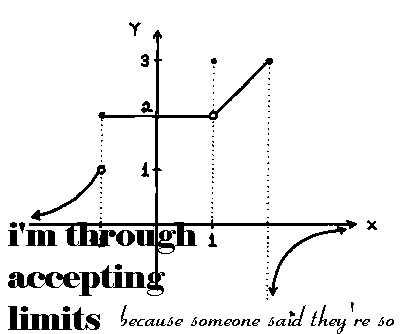
WOOHOO LAST 7AM TEST EVERRRR TMRW? PROBABLY!
OK. INTEGRALS
So integrals are the opposite of derivatives. The integral sign looks like a funky squiggly seahorse stretched out S thing. It's later than normal so there will probably be lots of strange things in this spiel, but bear with me if you want. The antiderivative way is to basically just like, undo everything, the ones where you can look at the thing and find the integral, like for S sinxdx, you know that the answer must be -cosx + C. And the backwards power rule thing is super helpful but I can't really post that here. Always add C at the end or you will get in trouble! Unless you can solve for C. The indefinite ones, you can't solve for C. If they give you like a point or something, then you can plug it into find C.
PVA problems in this section are, imho, pretty straightforward. And if I get it, you probably get it, right? Just utilizing the stuff on needstatement page 4 and integraling everything, basically.
So, USUBBBBBB.
General rule is to find the most complicated looking thing, the thing with the highest degree or under the funkiest outside function, like a square root thing or something. Make that u. Find the derivative with respect to u, find du. And don't forget to add a dx at the end. The du should like somehow be able to cancel out the stuff in the integral expression that isn't be substituted by u. Sometimes you will have to solve for x so that everything in the S is a u, and that is the only variable. Sometimes things are kind of strange but then again calculus is kind of strange. And afterwards you put whatever u is back into the equation and simplify.
RELATED RATES
Ok. I don't really know, I used to understand related rates so well! I wish I still did. So basically, the key to these problems is to write down everything you're given and figure out what you still need. Essentially this is kind of just some weird twisted way of doing implicit differentiation. In that you just derive things with respect to a certain variable, usually t. And multiply by other rates and whatever the circumstance calls for. Usually word problems and don't forget units because that's silly. I just remember that these aren't terribly difficult, just really easy to overthink. Which I'm always wont to do, of course. I feel like I'm missing something about these though. AH EPIPHANY. Ok. So you take the formula of whatever it is you're trying to find. Say it's a volume. You derive it, so you get dv/dt= whatever the derivative is. And usually you're going to be solving for the derivative of one of the variables in the volume or whatever equation with respect to another variable, usually time. And basically you do that and you move everything else to one side and solve for it! YAYY I get it again. I don't think this is terribly clear though, I'm sorry.
LIMIT SUMMATIONS
I get this in theory but I'm pretty shaky in practice. So if you have n, the number of subdivisions/ rectangles, all you do is plug in the x values into the equation to get your y value, add up the sum from the left or right, depending if you are doing right or left sum. then multiply the entire thing by delta x, which is the interval between the rectangles, the base of the rectangle. If you don't have a number of rectangles, it's b-a/ n with the interval of the curve are you're trying to find being [a,b] Then you find Mi which is a + i delta x. Or if you're going for left sum, you want mi, which is a + (i-1) delta x. You then plug whatever you get for Mi/mi into the places of all the x's in the original function equation that you will be given. Solve with the funky summation thing. You do this by taking anything that isn't an i out, intelligently of course. And distribute the summation thing so that you end up getting things that look like the 4 formulas. And if you memorize the formulas, you are absolutely golden.
I think.. that's it?
Oh. Riemann's or something
Basically you do the same formula thing as you do for rightsum/leftsum xcept you use ci instead of Mi/mi because it doesn't matter which side you sum from because you're finding area and it's the same no matter what. Oh, and if you evaluate the thing using the limit process, then you are going to get the area as the number of subdivisions increasee towards infinity the results are more accurate than estimations. Basically, Riemann's says that instead of using hte funky sum limit thing, you can just rewrite it as an integral. Pretty straightforward. And solve it in accordance to these certain bounds, but we haven't learned that yet. And there are properties of definite integrals that are kind of straightforward, that pertains to adding them and such. And rules. if the integral of something is smaller than another function that means that it is lower because there's less area under the curves. This chapter reminds me of a dirty nerdy joke something about area beneath curves and I don't really know.
I think this is everything? Melissa, am I missing anything obvious?
No comments:
Post a Comment